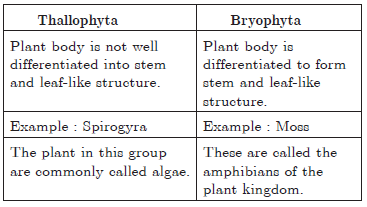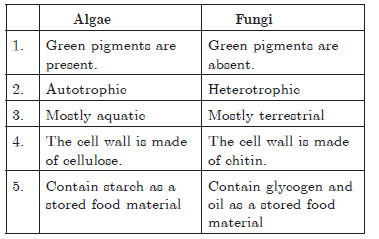Students should practice questions given in Diversity in Living Organisms Chapter 7 Class 9 Science Worksheets. These worksheets for Class 9 Science have a good collection of important questions and answers which are expected to come in your class tests and examinations. You should learn these solved worksheet questions for Science Class 9 as it will help you to understand all topics and give you more marks.
Class 9 Science Worksheets Chapter 7 Diversity in Living Organisms
Please refer to below questions and answers for Diversity in Living Organisms Chapter 7 Class 9 Science Worksheets. Prepared by expert teachers for Standard 9 Science
Question. Name the kingdom which includes monerans
Answer
Kingdom Monera.
Question. Give examples of the organism belonging to Monera and Protista kingdom.
Answer
Monera — Anabaena, blue-green algae.
Protista — Euglena, Paramecium, Amoeba.
Question. Name the appendages used for movement by organism belonging to Protista kingdom.
Answer
(a) Paramecium – Cilia
(b) Euglena – Flagella
(c) Amoeba – Pseudopodia
Question. Who proposed the two kingdom classification?
Answer
Carolus Linnaeus proposed the two kingdom classification.
Question. How are pores or holes all over the body of Porifera important?
Answer
The pores present all over the body of the organisms lead to a canal system that helps in circulating water throughout the body to bring in food and oxygen.
Question. Name the 5 kingdoms of living organisms.
Answer
1. Monera;
2. Protista;
3. Fungi, mycota;
4. Plantae; Metaphyto;
5. Animalia Metazoa.
Question. Give example of two fish which have skeleton made up of both bone and cartilage.
Tuna and rohu.
Answer
Question. If you are provided seeds of gram, wheat, rice,pumpkin, maize and pea. Classify these as Monocots/Dicots.
Answer
Monocots : Wheat, Rice, Maize.
Dicots : Gram, Pumpkin, Pea.
Question. What is lichen?
Answer
Lichen is the symbiotic association of fungi and bluegreen algae.
Question. What are Monerans?
Answer
Prokaryotic celled, unicellular and Autotrophic organisms.
Question. What is symbiotic relationship?
Answer
It is a relationship between two organisms in which both of them are benefitted, e.g., fungi gets food from blue-green algae and in return blue-green gets shelter (lichens).
Question. What are symbionts?
Answer
The association of 2 organisms in which both the organisms are mutually benefited are called symbionts.
Example : Fungi with algae as lichens.
Question. What is saprophytic nutrition?
Answer
The organisms that use dead and decaying organic matter as mode of nutrition is known as saprophytic nutrition.
Question. What is evolution?
Answer
Evolution is the change in heritance characteristics of organism over generations.
Question. Give simple classification of plant kingdom.
Answer
Kingdom plantae is divided in following divisions :
(a) Thallophyta
(b) Bryophyta
(c) Pteridophyta
(d) Phanerogams
(i) Gymnosperm
(ii) Angiosperm – (1) Monocots (2) Dicots
Question. Name the plant amphibian.
Answer
Bryophyta, e.g. funaria.
Question. What are cryptogamae?
Answer
The plants with hidden reproductive organs are called cryptogamae, e.g., fern.
Question. Give examples of pteridophyte.
Answer
Marsilea and fern.
Question. Name the reproductive organ of plants.
Answer
Flower.
Question. Which divisions of the plant kingdom are called cryptogams? Why are they called so?
Answer
Thallophyta, Bryophyta and Pteridophyta divisions of plant kingdom are called cryptogamae. All these divisions have hidden reproductive organs.
Question. What are gymnosperms?
Answer
Gynosperms are the group of plants that bear naked seeds, e.g., pines, deodar.
Question. Why bryophytes and pteriodophytes grow in moist and shady places?
Answer
Bryophytes and pteriodophytes need water for their reproduction. Because reproduction in these organisms can take place when water helps in carrying male gamete to female gamete.
Question. What are angiosperms?
Answer
Angiosperms are the group of plants with covered seeds. These are flowering plants.
Question. What are cotyledons?
Answer
Plant embryos in seeds have structures called cotyledons. Cotyledens are also known as seed leaves.
Question. Define radial symmetry.
Answer
When any plane axis passing through the central axis of the body divides the animal into two halves that are mirror image, is called radial symmetry. For example : sponges, starfish.
Question. What is the meaning of triploblastic?
Answer
Animals which have three layers of cells : ectoderm,mesoderm and endoderm from which differentiated tissues can be made, e.g. tapeworm.
Question. What is bilateral symmetry?
Answer
Anything is said to have bilateral symmetry if its body have same design in left and right halves of the body.
Question. What is biodiversity?
Answer
Various types of living organism found in a particular region is called biodiversity.
Question. What do you mean by “cold-blooded animals”?
Answer
Cold-blooded animals are the animals that show the variation in their body temperature according to the surroundings, e.g., fish, amphibians, reptiles.
Question. Write the name of three mammals that live in water.
Answer
Whale, platypus and dolphins.
Question. Name a fish with skeleton made up of cartilage.
Answer
Shark.
Question. Who made 1st attempt for scientific basis of classification?
Answer
Aristotle.
Question. Name parasitic flagellated protozoan.
Answer
Trypanosoma.
Question. Name the disease caused by Trypanosoma.
Answer
Sleeping sickness.
Question. On what morphological criteria Aristotle classified the plants?
Answer
Based on the morphological nature of the stem.
Question. Name the 2 kingdoms of classification?
Answer
(1) Plantae or Metaphyta
(2) Animalia or Metazoa
Question. What are prokaryotes? Give one example for prokaryote.
Answer
The organisms which do not have well organized nucleus in their cell are called prokaryotes. Organisms containing incipient nucleus (Nucleoid) in their cells are called prokaryotes. Example : Bacteria, Nostoc (cyano bacteria/ B.G. Algae)
Question. What are Eukaryotes? Give an example of Eukaryotes?
Answer
Organisms which have well organized nuclei (True nucleus) are called Eukaryotes.
Example : Amoeba, mango, Man.
Question. Name the writer who wrote the book “The Origin of Species”.
Answer
Charles Darwin wrote the book “The Origin of Species” in 1859.
Question. Who proposed the classification of organisms into 5 kingdoms?
Answer
Robert H. Whittaker proposed the classification of organisms into 5 kingdoms in 1959.
Question. Give the characteristics of Protista.
Answer.
(a) Organisms are unicellular and eukaryotic.
(b) Locomotion is possible by using parts like cilia, flagella, etc.
(c) Nutrition is either autotrophic or heterotrophic.
(d) E.g., algae, protozoa.
Question. What are hermaphrodites? Give two examples.
Answer. Hermaphrodites are the organisms that have both the sexes. Thus, it can produce both sperms and eggs and called hermaphrodites. Example : Sponges, earthworms.
Question. Give the difference between radial and bilateral symmetry.
Answer.

Question. Due to global warming coral is getting diminished in all the oceans/ water bodies. People in Lakshadweep island protects their corals by not allowing people/ tourist to take few pieces away.
(a) Name the phylum of coral.
(b) What is coral made up of?
(c) What values of people in Lakshadweep island is reflected?
Answer.
(a) Phylum of coral is coelenterata.
(b) Coral is made up of calcium carbonate.
(c) People in Lakshadweep island reflect the value of being responsible (Citizen, respecting environment and nature).
Question. Differentiate between vertebrates and invertebrates.
Answer.

Question. Write the two characteristic features of kingdom protista?
Answer.
(1) All are single celled eukaryotes.
(2) It includes plant protists (photosynthetic protozoan) and animal protozoan’s (protista).
(3) Some prostistan members have flagella or cilia as locomotary organs.
(4) Protists reproduce asexually by binary fission and sexually by a process involving cell fission and zygote formation.
Question. Name the phylum of the following animals :
(a) Tapeworm
(b) Starfish
(c) Jellyfish
(d) Octopus
Answer.
(a) Tapeworm — Platyhelminthes
(b) Starfish — Echinodermata
(c) Jellyfish — Coelenterata
(d) Octopus — Mollusca
Question. State the features of all chordates.
Answer.

Figure: Amphioxus
All chordates possess the following features :
1. Have a notochord
2. Have a dorsal nerve chord
3. Are triploblastic
4. Bilaterally symmetrical body
5. Respire through lungs on land and through gills in water
Question. A group of students had gone for educational trip clicked photographs of endangered plants. These photographs were used by the school laboratory to study these plants.
(i) Name two endangered plants.
(ii) Name any one medicinal plant and give its medicinal use.
Answer.
(i) Two endangered plants are Euphrasia and Ubnus rubra.
(ii) Aloe-vera : Juice of Aloe-vera is used in case of indigestion, treating skin infection, etc.
Question. Give general characteristics of ‘Platyhelminthes’.
Answer.

(a) Flatworms
(c) Triploblastic animal
(b) Parasitic mode of nutrition
(d) No true internal body cavity
Example : Tapeworm, planaria, liver fluke.
Question. Give general characteristics of Porifera.
Answer.
(a) Animals with pores all over the body.
(b) Body is not well differentiated.
(c) Non-motile animals remain attached to solid support.
(d) Body is covered with hard outer skeleton. Example : Sponges.
Question. Give the characteristics of Monera.
Answer.
(a) Organisms are unicellular and do not have a defined nucleus.
(b) Some organisms can have cell wall while some cannot.
(c) Cell organelles are not covered with double membrane.
(d) Autotrophic or Heterotrophic.

Figure: Monera Family
Question. Give the characteristics of Arthropoda with 2 examples.
Answer.(a) Arthropoda means jointed legs.
(b) Animals are bilaterally symmetrical and segmented.
(c) It has an open circulatory system.
(d) This is the largest group of animals.
Examples : Spider, scorpions, crabs, house flies.
Question. Give the difference between thallophyta and bryophyta.
Answer.

Question. Give the difference between monocots and dicots.
Answer.


Question. Write the general characteristics of kingdom – fungi.
Answer.
(1) The fungi are the unique heterotrophic organisms either saprophytic or parasitic or symbiotic.
(2) The fungi are cosmopolitan in distribution and occur in air, water, soil and on plants and animals.
(3) They are unicellular (yeast) or multicellular, eukaryotic organisms.
(4) Fungi are filamentous and the body consisting of long, slender thread-like structures called hyphae, may be coenocytes hyphane or septate hyphore.
(5) The network of hyphae in fungi is called mycelium.
(6) The cell walls of fungi are composed of chitin and polysaccharides.
(7) Reproduction in fungi can take place by three methods :
(a) Vegetative
(b) Asexual
(c) Sexual reproduction.
Question. What is the importance of classification?
Answer. Classification is important because :
(a) Classification makes the study of wide variety of organisms systematic and easier.
(b) It projects a picture of all organisms and their interrelation with each other.
(c) It provides a base for the study of other branches of biology.
(d) It is useful in the study of ecology, which deals with the inter-relation of an organism with their environment.
(e) It helps to establish a hierarchy of groups of organisms.
Question. What are the characteristic features of mammals?
Answer. Characteristic features of mammals :
(a) Body is covered with hair.
(b) Skin is provided with sweat and sebaceous glands.
(c) Heart is four-chambered.
(d) Fertilization is internal.
(e) Females have mammary glands to produce milk to nourish their young ones.
(f) External ear–pinna present.
(g) Eyes have eye lids.
(h) Warm-blooded.
(i) Respiration through lungs.
Question. What are the characteristic features of reptiles?
Answer.
The characteristics of reptiles :
(a) Dry scaly, impermeable skin.
(b) Respiration through lungs.
(c) Cold-blooded
(d) Internal fertilization.
(e) Heart is three chambered.
(f) Two pairs of pentadactyl limbs are present.
Question. What is the basis for classification of organisms?
Answer.
The basis for classification are :
(a) Presence or absence of nucleus.
(b) Organisms are unicellular, or multicellular.
(c) Autotrophic mode of nutrition or heterotrophic mode of nutrition.
(d) Of the organisms that perform photosynthesis (plants), their level, or organisation of the body.
(e) Of the animals, how does the individuals body develop and organise its different parts.
Question. Give difference between algae and Fungi ?
Answer.

Question.Give the classification of plant kingdom.
Answer.

Question. Give difference between Cryptogamae and Phanaerogamae.
Answer.
